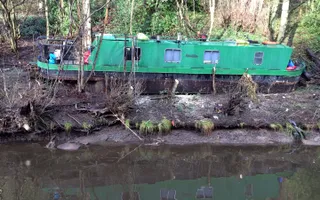1. Check ropes
Build in some slack to accommodate changes in water levels. Tight ropes can be a real hazard; if water levels rise or fall they will cause the vessel to list, potentially putting the outlets under water, resulting in water ingress.
2. Mooring locations
Some mooring locations can place a vessel in danger, particularly where water levels fluctuate. Although it can be impossible to choose where to moor when a river is in flood, it's worth taking time to check the bank and identify what the underwater bed is like. If there's a steep fall or shallow bank, when the water recedes, the boat will list.
In addition, consider the flow of the water and how it will affect the mooring – will it push or pull the boat and could it cause problems with other mooring points? Several boats sunk in the recent floods because they were subject to water level changes which left them at an angle with outlets allowing water in.
3. Drain holes
Keep drain holes clear by regularly cleaning them out. Over time they can become blocked with debris and corroded. If this happens, water may leak into the engine compartment and the alternators and starter motors, affecting charging and starting. If the bilge pump is manual, or the automatic pump fails due to a low running battery (which happens when worked continuously), the engine room could fill with water.
4. Bilge
Ensure bilge pumps are working and install an automatic float switch. All bilge pumps provide some protection from water ingress but only ones with an automatic switch will protect the vessel if you're not around. Bilge pumps without an automatic switch are reliant on the owner manually turning them on.
Unfortunately, most of the boat sinkings we attend are for vessels with manual pumps; had a switch been present, I suspect in many cases, they would still be afloat.
5. Top up your battery
If you're leaving your vessel for any period of time, it's vital the battery is in a good condition with a good level of charge. If you have an automatic bilge pump, its operation is reliant on the battery; most batteries with a good charge can operate a pump for one week to 10 days with a bilge pump continuously running. To charge the battery, frequently run the engine for a minimum of one to two hours.
It's also worth finding out how long your battery will last on continuous use so if there is heavy rain, you can gauge how often to visit the boat.
River Canal Rescue runs a series of boat and engine maintenance and electrics courses at its head office in Stafford throughout the year, or its team can run courses anywhere in the country.
To find out more visit www.rivercanalrescue.co.uk





